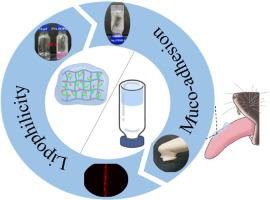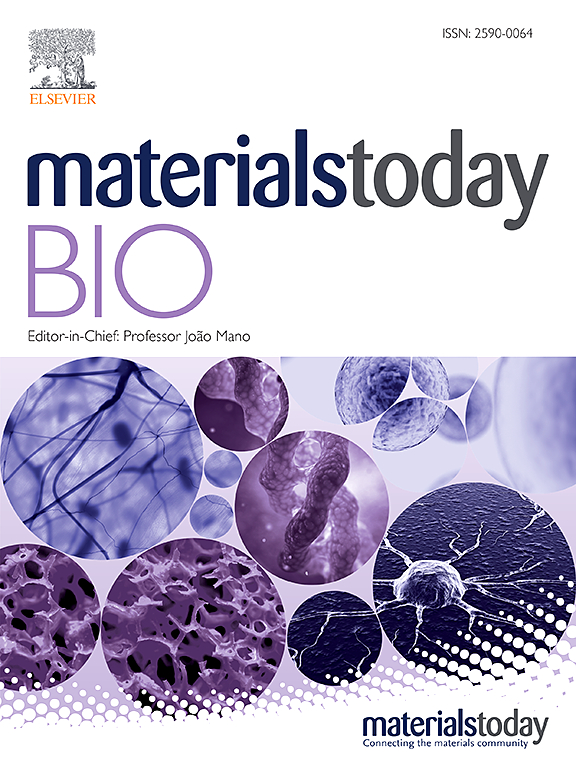Adhesive lipophilic gels delivering rapamycin prevent oral leukoplakia from malignant transformation
IF 8.7
1区 医学
Q1 ENGINEERING, BIOMEDICAL
引用次数: 0
Abstract
Oral leukoplakia (OLK) is the most emblematic oral potentially malignant disorder that may precede the diagnosis of oral squamous cell carcinoma (OSCC) and has an overall malignant transformation rate of 9.8 %. Early intervention is crucial to reduce the malignant transformation rate from OLK to OSCC but the lack of effective local pharmaceutical preparations poses a challenge to clinical management. Rapamycin is speculated to prevent OLK from carcinogenesis and its inherent lipophilicity facilitates its penetration into stratum corneum. Nevertheless, hydrophilic hydrogels frequently encounter challenges when attempting to deliver lipophilic drugs. Furthermore, the oral cavity presents a complex environment defined by oral motor functions, saliva secretion cycles, dynamic fluctuations, and protective barriers comprising mucus and lipid layers. Consequently, addressing issues of muco-penetration and muco-adhesion is imperative for developing an effective drug delivery system aiming at delivering rapamycin to target oral potentially malignant disorders.
Here, a dual-function hydrogel drug delivery system integrating adhesion and lipophilicity was successfully developed based on polyvinyl alcohol (PVA) and dioleoyl phosphatidylglycerol (DOPG) via dynamic boronic ester bonds. Rheological experiments based on orthogonal design revealed that PVA-DOPG hydrogels exhibited ideal adhesive strength (around 6 kPa) and could adhere to various surfaces in both dry and wet conditions. PVA-DOPG hydrogels also significantly promoted lipophilic molecules’ penetration into stratum corneum (integrated fluorescence density of 6.95 ± 0.52 × 106 and mean fluorescence depth of 0.96 ± 0.07 mm) of ex-vivo porcine buccal mucosa (p < 0.001). Furthermore, PVA-DOPG hydrogels incorporating rapamycin inhibited malignant transformation of OLK mouse model induced by 4-Nitroquinoline N-oxide (4-NQO), distinct improvements in survival (the neoplasm incidence density at the 40th day is 0.0091) (p < 0.05), decrease in neoplasm incidence density of 36.36 % and inhibition rate in neoplasm volume of 75.04 ± 33.67 % have been demonstrated, suggesting the hydrogels were valuable candidates for potential applications in the management of OLK.

输送雷帕霉素的亲脂性粘性凝胶可防止口腔白斑病恶变
口腔白斑病(OLK)是最具代表性的口腔潜在恶性疾病,可发生在口腔鳞状细胞癌(OSCC)确诊之前,其总体恶变率为 9.8%。早期干预对于降低口腔鳞状细胞癌向 OSCC 的恶性转化率至关重要,但缺乏有效的局部药物制剂给临床治疗带来了挑战。据推测,雷帕霉素可防止 OLK 发生癌变,其固有的亲脂性有利于其渗透角质层。然而,亲水性水凝胶在尝试递送亲脂性药物时经常会遇到挑战。此外,口腔是一个复杂的环境,由口腔运动功能、唾液分泌周期、动态波动以及由粘液和脂质层组成的保护屏障所决定。因此,解决粘液渗透和粘液粘附问题是开发有效给药系统的当务之急,该系统旨在针对口腔潜在恶性疾病输送雷帕霉素。在此,我们成功开发了一种集粘附性和亲油性于一体的双功能水凝胶给药系统,该系统以聚乙烯醇(PVA)和二油酰磷脂酰甘油(DOPG)为基础,通过动态硼酸酯键实现。基于正交设计的流变学实验表明,PVA-DOPG 水凝胶具有理想的粘合强度(约 6 kPa),在干燥和潮湿条件下都能粘附在各种表面上。PVA-DOPG 水凝胶还能显著促进亲脂分子渗透到活体猪口腔粘膜角质层(综合荧光密度为 6.95 ± 0.52 × 106,平均荧光深度为 0.96 ± 0.07 mm)(p < 0.001)。此外,含有雷帕霉素的 PVA-DOPG 水凝胶抑制了 4-硝基喹啉 N-氧化物(4-NQO)诱导的 OLK 小鼠模型的恶性转化,明显提高了存活率(第 40 天的肿瘤发病密度为 0.0091) (p < 0.05),肿瘤发病密度降低了 36.36 %,肿瘤体积的抑制率为 75.04 ± 33.67 %,这表明水凝胶在治疗 OLK 方面具有潜在的应用价值。
本文章由计算机程序翻译,如有差异,请以英文原文为准。
求助全文
约1分钟内获得全文
求助全文
来源期刊

Materials Today Bio
Multiple-
CiteScore
8.30
自引率
4.90%
发文量
303
审稿时长
30 days
期刊介绍:
Materials Today Bio is a multidisciplinary journal that specializes in the intersection between biology and materials science, chemistry, physics, engineering, and medicine. It covers various aspects such as the design and assembly of new structures, their interaction with biological systems, functionalization, bioimaging, therapies, and diagnostics in healthcare. The journal aims to showcase the most significant advancements and discoveries in this field. As part of the Materials Today family, Materials Today Bio provides rigorous peer review, quick decision-making, and high visibility for authors. It is indexed in Scopus, PubMed Central, Emerging Sources, Citation Index (ESCI), and Directory of Open Access Journals (DOAJ).
 求助内容:
求助内容: 应助结果提醒方式:
应助结果提醒方式:


